List of World Heritage Sites in Brazil

The United Nations Educational, Scientific and Cultural Organization (UNESCO) World Heritage Sites are places of importance to cultural or natural heritage as described in the UNESCO World Heritage Convention, established in 1972.[1] Brazil accepted the convention on September 1, 1977, making its historical sites eligible for inclusion on the list.[2]
Sites in Brazil were first inscribed on the list at the 4th Session of the World Heritage Committee, held in Paris, France in 1980. At that session, one site was added: the "Historic Town of Ouro Preto".[3] As of July 2014, Brazil has 19 total sites inscribed on the list. Of these one site is shared with other countries: "Jesuit Missions of the Guaranis:" with Argentina. Seven World Heritage Sites in Brazil are of the natural type, all others are cultural sites.[2]
World Heritage Sites
The table lists information about each World Heritage Site:
- Name: as listed by the World Heritage Committee
- Location: city and region of site
- Area: size of property and buffer zone
- UNESCO data: the site's reference number; the year the site was inscribed on the World Heritage List; the criteria it was listed under: criteria i through vi are cultural, while vii through x are natural; (the column sorts by year added to the list)
- Description: brief description of the site
| Site | Image | Location | Area ha (acre) |
UNESCO data | Description |
|---|---|---|---|---|---|
| Atlantic Forest South-East Reserves | |
Paraná, São Paulo and Rio de Janeiro states, 24°10′S 48°0′W / 24.167°S 48.000°W |
468,193 (1,156,930); buffer zone 1,223,557 (3,023,480) | 893; 1999; vii, ix, x | The site comprises some of the last remaining Atlantic Forests and shows a very high diversity with many rare and endemic species. As such it is of high interest both for scientists and for conservation.[4] |
| Brasília |  |
Federal District, 15°47′S 47°54′W / 15.783°S 47.900°W |
— | 445; 1987; i, iv | Planned and developed by Lúcio Costa and Oscar Niemeyer in 1956, Brasília was created ex nihilo in order to move the capital from Rio de Janeiro to a more central position. Together with Chandigarh in India it is the only place where Corbusier's design principles of urbanism have been applied on large scale.[5] |
| Brazilian Atlantic Islands: Fernando de Noronha and Atol das Rocas Reserves | 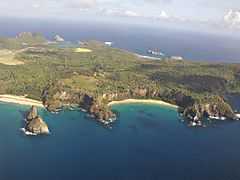 |
Pernambuco and Rio Grande do Norte, 3°51′29″S 32°25′30″W / 3.85806°S 32.42500°W |
42,270 (104,500); buffer zone 140,713 (347,710) | 1000; 2001; vii, ix, x | As one of the few insular habitats in the South Atlantic, the site is essential as feeding ground and reproduction space for marine organisms including endangered and threatened species, most notably the Hawksbill sea turtle.[6] |
| Central Amazon Conservation Complex | 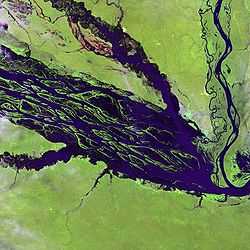 |
State of Amazonas, 2°20′0″S 62°0′30″W / 2.33333°S 62.00833°W |
5,323,018 (13,153,460) | 998; 2000; [nb 1] ix, x |
As the largest protected area in the Amazon Basin, the site is notable for its high biodiversity, range of habitats such as várzea and igapó forests and number of endangered species. It has been recognized by various conservation agencies as a high priority region.[nb 2][7] [8] |
| Cerrado Protected Areas: Chapada dos Veadeiros and Emas National Parks | 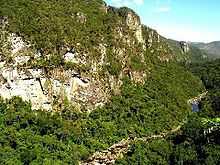 |
Central Brazil Plateau, State of Goiás, 14°0′20″S 47°41′5″W / 14.00556°S 47.68472°W |
367,356 (907,760) | 1035; 2001; ix, x | The two parks are characteristic of the cerrado, one of the world's oldest tropical ecosystems and an important refuge for species in times of climate change.[9] |
| Discovery Coast Atlantic Forest Reserves | 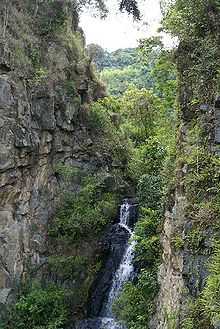 |
Atlantic Coast, Bahia and Espírito Santo states, 16°30′S 39°15′W / 16.500°S 39.250°W |
111,930 (276,600) | 892; 1999; ix, x | The site comprises some of the last remaining Atlantic Forests and shows a very high diversity with many rare and endemic species. As such it is of high interest both for scientists and for conservation.[10] |
| Historic Centre of Salvador de Bahia | 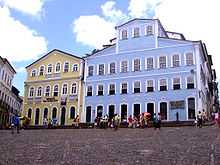 |
Bahia state, 12°58′0″S 38°30′0″W / 12.96667°S 38.50000°W |
— | 309; 1985; iv, vi | The colonial old town of the first Brazilian capital and town of the first slave market in the New World, has preserved a large number of brightly colored Renaissance houses decorated with stucco work from the 16th to 18th centuries.[11] |
| Historic Centre of São Luís | |
Maranhão state, 2°30′51″S 44°18′9″W / 2.51417°S 44.30250°W |
— | 821; 1997; iii, iv, v | São Luís has preserved the complete rectangular town plan and a large number of historical buildings making it a prime example of a Portuguese colonial town.[12] |
| Historic Centre of the Town of Diamantina | 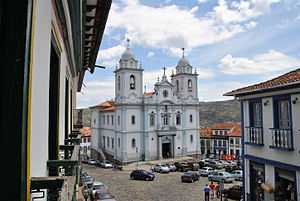 |
Minas Gerais, 18°40′0″S 43°36′0″W / 18.66667°S 43.60000°W |
29 (72) | 890; 1999; ii, iv | A well-preserved example of Baroque architecture, this 18th-century colonial town was founded in an inhospitable environment of rocky mountains and became a center of diamond mining in the 18th and 19th centuries.[13] |
| Historic Centre of the Town of Goiás | 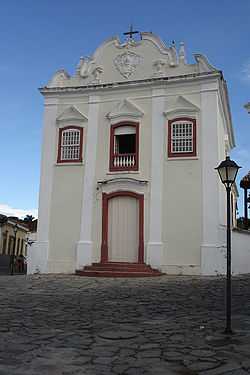 |
Goiás, 15°56′0″S 50°8′0″W / 15.93333°S 50.13333°W |
40 (99); buffer zone 44 (110) | 993; 2001; ii, iv | Founded in 1727 by the bandeirante explorer Bartolomeu Bueno da Silva, Goiás has preserved much of its colonial heritage and is an example of a European settlement in the interior of South America.[14] |
| Historic Centre of the Town of Olinda | 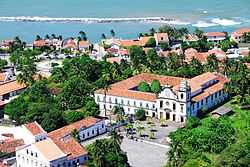 |
Pernambuco, 8°0′48″S 34°50′42″W / 8.01333°S 34.84500°W |
120 (300); buffer zone 920 (2,300) | 189; 1982; ii, iv | Founded in 1537 the town prospered as a centre of sugar-cane production. Following looting by the Dutch in the 17th century, the historic centre dates largely to the 18th century with a harmonious combination of buildings, gardens, churches, convents and chapels.[15] |
| Historic Town of Ouro Preto | 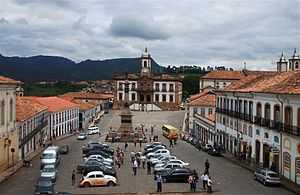 |
Minas Gerais, 20°23′20″S 43°30′20″W / 20.38889°S 43.50556°W |
— | 124; 1980; i, iii | The prosperity of the town as the center of the Brazilian gold rush in the 18th century is reflected in a large number of preserved churches, bridges and fountains many of them designed by the Baroque sculptor Aleijadinho.[16] |
| Iguaçu National Park | 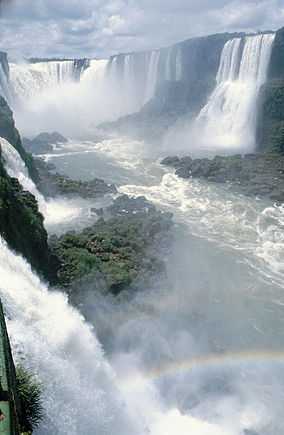 |
Paraná, 25°41′S 54°26′W / 25.683°S 54.433°W |
170,086 (420,290) | 355; 1986; vii, x | Together with Iguazú National Park on the Argentinian side, the park protects Iguazu Falls, one of the world's largest waterfalls, and is home to many rare and endangered species such as Giant Anteater or the Giant Otter. The site had been listed as endangered 1999–2001 due to an illegally opened road through the park, dams on the Iguazu River and helicopter flights.[17] |
| Jesuit Missions of the Guaranis: San Ignacio Miní, Santa Ana, Nuestra Señora de Loreto and Santa María Mayor (Argentina), Ruins of São Miguel das Missões (Brazil) | 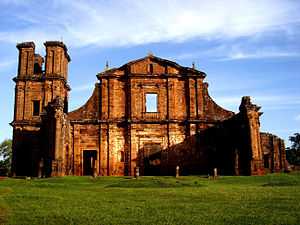 |
Misiones Province, 28°32′36″S 54°15′57″W / 28.54333°S 54.26583°W |
— | 275; 1983;[nb 3] iv | Each of the five ruined Jesuit missions founded amidst a tropical forest in the land of the Guaraní people in the 17th and 18th centuries is characterized by a specific design.[18] [19] |
| Pantanal Conservation Area | 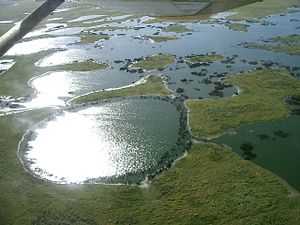 |
Mato Grosso do Sul and Mato Grosso, 17°43′S 57°23′W / 17.717°S 57.383°W |
187,818 (464,110) | 999; 2000; vii, ix, x | [20] |
| Rio de Janeiro: Carioca Landscapes Between the Mountain and the Sea | |
Rio de Janeiro, 22°56′52″S 43°17′29″W / 22.94778°S 43.29139°W |
7,249 (17,910); buffer zone 8,621 (21,300) | 1100; 2012; vi | The listed site consists of an exceptional urban setting rather than built heritage. It encompasses the key natural elements that have shaped and inspired the development of the city: from the highest points of the Tijuca National Park’s mountains down to the sea. They also include the Botanical Gardens, established in 1808, Corcovado Mountain with its celebrated statue of Christ and the hills around Guanabara Bay, including the extensive designed landscapes along Copacabana Bay which have contributed to the outdoor living culture of this spectacular city. Rio de Janeiro is also recognized for the artistic inspiration it has provided to musicians, landscapers and urbanists.[21] |
| Sanctuary of Bom Jesus do Congonhas | 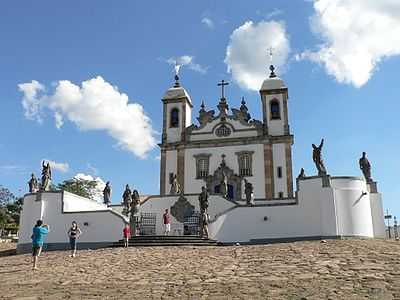 |
Congonhas, Minas Gerais, 20°29′59″S 43°51′28″W / 20.49972°S 43.85778°W |
— | 334; 1985; i, iv | [22] |
| São Francisco Square in the Town of São Cristóvão |  |
São Cristóvão, Sergipe, 11°0′58″S 37°12′36″W / 11.01611°S 37.21000°W |
3.00 (7.4); buffer zone 2,500 (6,200) | 1272; 2010; ii, iv | [23] |
| Serra da Capivara National Park | |
Piauí, 8°25′0″S 42°20′0″W / 8.41667°S 42.33333°W |
— | 606; 1991; iii | [24] |
Tentative List
In addition to sites inscribed on the World Heritage list, member states can maintain a list of tentative sites that they may consider for nomination. Nominations for the World Heritage list are only accepted if the site was previously listed on the tentative list.[25] As of 2014, Brazil recorded 18 sites on its tentative list. The sites, along with the date they were included on the tentative list are:[2]
- Réserve biologique d'Atol das Rocas (Rio Grande do Norte) (06/09/1996)
- Anavilhanas Ecological Station (16/09/1998)
- Canyon du Rio Peruaçu, Minas Gerais (11/03/1998)
- Cavernas do Peruaçu Federal Environmental Protection Area (APA) / Veredas Do Peruaçu State Park (16/09/1998)
- Cultural Landscape of Paranapiacaba: Village and railway systems in the Serra do Mar Mountain Range, São Paulo (27/02/2014)
- Eglise et Monastère de Sao Bento, Rio de Janeiro (06/09/1996)
- Ensemble architectonique de tourisme et loisir au bord du lac de Pampulha (06/09/1996)
- Gold Route in Parati and its landscape (08/01/2004)
- Palais de la Culture, ancien siège du Ministère de l'Education et de la Santé, Rio de Janeiro (06/09/1996)
- Parc national de la Serra da Bocaina (São Paulo - Rio de Janeiro) (06/09/1996)
- Parc national du Pico da Neblina (Amazonas) (06/09/1996)
- Serra da Canastra National Park (16/09/1998)
- Serra da Capivara National Park and Permanent Preservation Areas (16/09/1998)
- Serra do Divisor National Park (16/09/1998)
- Station écologique de Taim (Rio Grande do Sul) (06/09/1996)
- Station écologique du Raso da Catarina (Bahia) (06/09/1996)
- Valongo Wharf Archaeological Site (31/01/2014)
- Ver-o-Peso (27/02/2014)
Notes
- ↑ Extended in 2003 to include the Amana Sustainable Development Reserve, the Demonstration area of the Mamirauá Sustainable Development Reserve and the Anavilhanas Ecological Station; and name change from Jaú National Park, Brazil to the present name.
- ↑ It is a Centre of Plant Diversity, an Endemic Bird Area of the World and a Global 200 ecoregion.
- ↑ Extended in 1984 to include the four Argentinian missions making it a trans-border site; and name change from The Ruins of São Miguel das Missões to the present name.
References
- ↑ "The World Heritage Convention". UNESCO. Retrieved September 17, 2010.
- ↑ 2.0 2.1 2.2 "Brazil – Properties inscribed on the World Heritage List". UNESCO. Retrieved July 29, 2014.
- ↑ "Report of the Rapporteur". UNESCO. September 29, 1980. Retrieved July 12, 2014.
- ↑ "Atlantic Forest South-East Reserves". UNESCO. Retrieved 28 May 2010.
- ↑ "Brasília". UNESCO. Retrieved 28 May 2010.
- ↑ "Brazilian Atlantic Islands: Fernando de Noronha and Atol das Rocas Reserves". UNESCO. Retrieved 28 May 2010.
- ↑ "Central Amazon Conservation Complex". UNESCO. Retrieved 28 May 2010.
- ↑ "Decision - 27COM 8C.10 - Central Amazon Conservation Complex (Brazil)". UNESCO. Retrieved 26 September 2011.
- ↑ "Cerrado Protected Areas: Chapada dos Veadeiros and Emas National Parks". UNESCO. Retrieved 28 May 2010.
- ↑ "Discovery Coast Atlantic Forest Reserves". UNESCO. Retrieved 28 May 2010.
- ↑ "Historic Centre of Salvador de Bahia". UNESCO. Retrieved 28 May 2010.
- ↑ "Historic Centre of São Luís". UNESCO. Retrieved 28 May 2010.
- ↑ "Historic Centre of the Town of Diamantina". UNESCO. Retrieved 28 May 2010.
- ↑ "Historic Centre of the Town of Goiás". UNESCO. Retrieved 10 September 2011.
- ↑ "Historic Centre of the Town of Olinda". UNESCO. Retrieved 10 September 2011.
- ↑ "Historic Town of Ouro Preto". UNESCO. Retrieved 10 September 2011.
- ↑ "Iguaçu National Park". UNESCO. Retrieved 10 September 2011.
- ↑ "Jesuit Missions of the Guaranis: San Ignacio Mini, Santa Ana, Nuestra Señora de Loreto and Santa Maria Mayor (Argentina), Ruins of Sao Miguel das Missoes (Brazil)". UNESCO. Retrieved 8 September 2011.
- ↑ "Jesuit Missions of the Guaranis". UNESCO. Retrieved 8 September 2011.
- ↑ "Pantanal Conservation Area". UNESCO. Retrieved 10 September 2011.
- ↑ "Rio de Janeiro: Carioca Landscapes between the Mountain and the Sea". UNESCO. Retrieved July 2, 2011.
- ↑ "Sanctuary of Bom Jesus do Congonhas". UNESCO. Retrieved 10 September 2011.
- ↑ "São Francisco Square in the Town of São Cristóvão". UNESCO. Retrieved 10 September 2011.
- ↑ "Serra da Capivara National Park". UNESCO. Retrieved 10 September 2011.
- ↑ "Tentative Lists". UNESCO. Retrieved July 12, 2014.
| |||||||||||||||||||||||||||||
| ||||||||||||||||||||||||||||||||||||||
| ||||||||||||||||
| ||||||||

